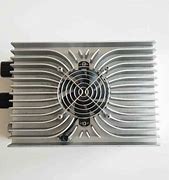An on-board charger is a versatile and essential tool for anyone who loves to work on projects in remote locations, go camping, or simply needs a reliable portable power source. Rather than purchasing a pre-made on-board charger, why not consider assembling one yourself? In this DIY guide, we'll walk you through the steps to assemble an on-board charger, providing you with a personalized and cost-effective solution for all your power needs.
Materials and Tools You'll Need
Before diving into the assembly process, you'll need to gather the necessary materials and tools. Here's a list to get you started:
Materials:
Battery: Choose a suitable battery with the capacity you need. Deep-cycle lead-acid batteries or lithium-ion batteries are common choices.
Battery Charger/Power Supply: This is the component that will recharge your battery when it runs low. It should be compatible with your chosen battery type.
Inverter (optional): If you want to power AC devices, you'll need an inverter. Make sure it's rated for the wattage you require.
Battery Box or Enclosure: A container to house and protect your battery and other components.
Wiring: High-quality, thick-gauge wires for connecting components. Make sure to have various connectors and crimping tools.
Fuses and Fuse Holders: For safety, it's crucial to include fuses in your wiring to protect against short circuits.
Voltmeter: To monitor the battery's voltage.
Tools:
Screwdrivers and wrenches: For attaching components and securing your assembly.
Wire cutters and strippers: To prepare the wires for connection.
Soldering iron and solder: For secure and reliable connections.
Multimeter: To measure voltage and check for proper connections.
Drill and bits: For creating holes to mount components and run wires.
Safety gear: Safety glasses, gloves, and a well-ventilated workspace are essential for your protection.
Step-by-Step Guide to Assemble Your On-Board Charger

1. Plan Your Setup:
Start by determining the desired configuration for your on-board charger. Decide where each component will be placed within the battery box or enclosure. Ensure there's enough space and ventilation to prevent overheating.
2. Install the Battery:
Carefully place your chosen battery into the battery box or enclosure. Make sure it's securely fastened to prevent movement during transportation.
3. Install the Charger/Power Supply:
Mount the battery charger or power supply inside the enclosure, making sure to follow the manufacturer's instructions for proper installation. Connect the charger to the battery using appropriate-sized wires.
4. Add an Inverter (if needed):
If you want to power AC devices, install the inverter and connect it to the battery. Ensure the inverter is appropriately rated to handle your intended load.
5. Wiring and Connections:
Wire your components together, making sure to connect the positive terminals with positive terminals and negative terminals with negative terminals. Use crimp connectors and solder for secure connections. Incorporate fuses into your wiring to prevent short circuits.

6. Install a Voltmeter:
Mount a voltmeter on the exterior of the enclosure to monitor the battery's voltage. Connect it to the battery using appropriate wires.
7. Test Your Charger:
Before sealing everything up, test your on-board charger to ensure that it's functioning correctly. Use a multimeter to measure the voltage output and check that your inverter (if included) works as expected.
8. Secure and Seal:
After verifying that everything works, secure all components within the enclosure. Seal any openings or gaps to protect the electronics from the elements.
9. Safety Check:
Double-check all connections and ensure that everything is secured properly. Safety should always be a priority when dealing with electrical components.
Conclusion
Assembling an on-board charger can be a fulfilling DIY project, giving you a portable power source for your various needs. It's essential to carefully plan your setup, use quality components, and prioritize safety throughout the assembly process. With the right materials, tools, and a bit of technical know-how, you'll have a custom on-board charger that allows you to power your projects, devices, and appliances wherever your adventures take you. Happy DIYing!
Next:How Many Kilowatts On-Board Charger Do You Need?
Previous:The On-Board Charger Cable: Powering the Future of Electric Vehicles
Contact Person: Miss. Kiki
| WhatsApp : | +8617763224709 |
|---|---|
| Skype : | +8617763224709 |
| WeChat : | +8617763224709 |
| Email : | kiki@lifepo4-battery.com |